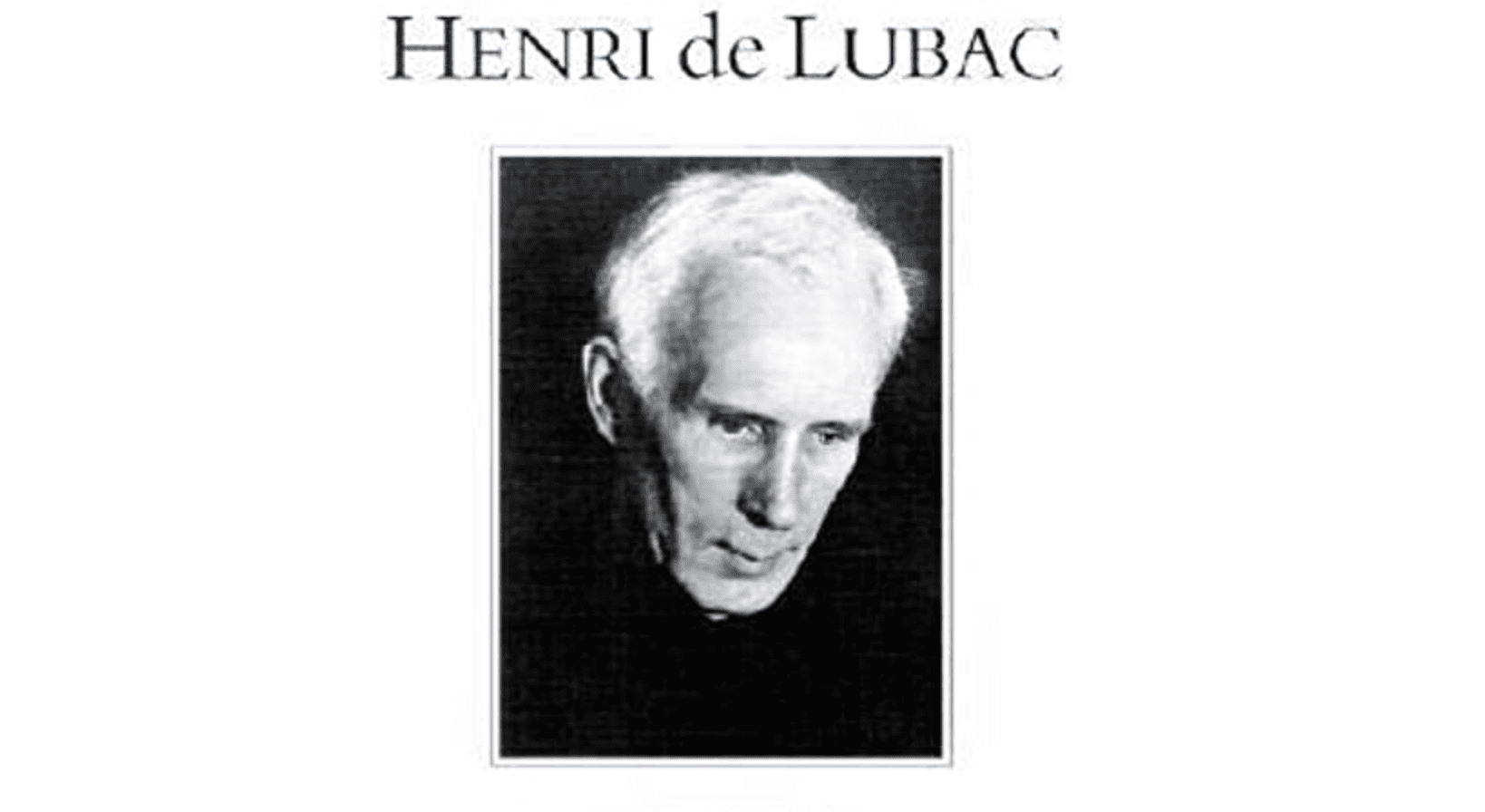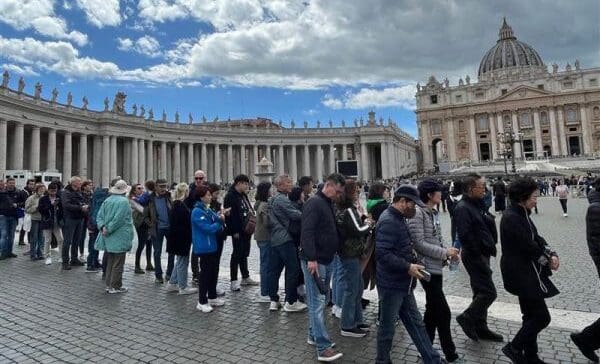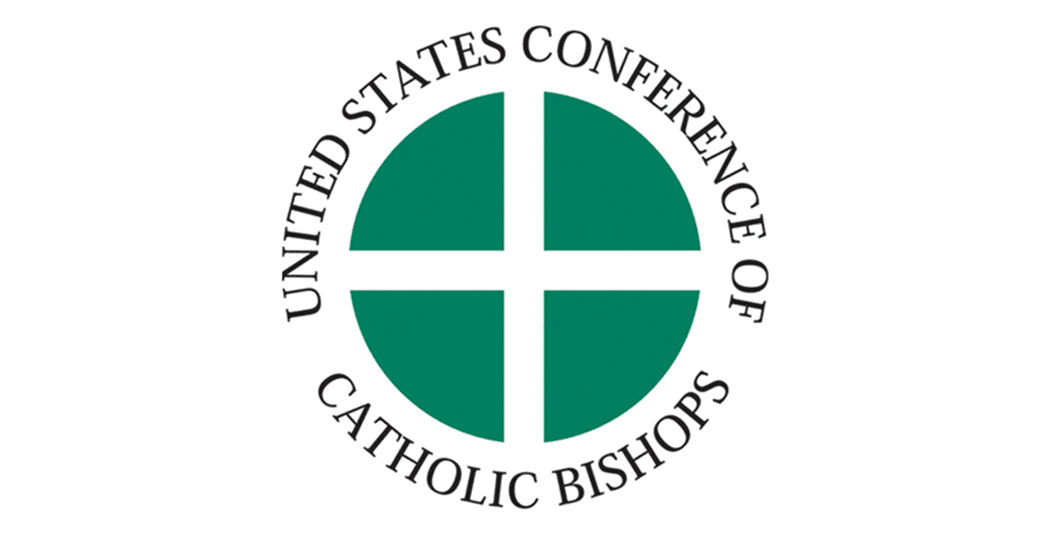Liturgical renewal leads to renewal in the life of the Church. To this end, in the late 19th century, theologians returned to biblical and patristic sources, read through authentic liturgical development, to study anew the mystery of the Eucharist and the Church. Essentially, the hope was to enable the faithful to engage the sacraments and liturgy more deeply so that they could undertake the mission of evangelization with greater effectiveness.
In particular, a revitalized understanding of the Church as communion or mystical body, if lived and interiorized by the faithful, could indeed resist the fragmenting effects of modernity and what we now call “post-modernity.”1 The Eucharistic theology of Henri de Lubac has proven prophetic in this regard. De Lubac was a peritus at the Second Vatican Council who stated, “The Church makes the Eucharist and the Eucharist makes the Church.” It is a maxim that has shaped the Second Vatican Council and the subsequent theology of the Church, having been quoted in both the Catechism of the Catholic Church and St. John Paul II’s last encyclical, his 2003 Ecclesia de Eucharistia.
Indeed, such pithy yet profound sayings among the Church’s thinkers have a tendency to take on a life of their own. Consider St. Augustine’s often quoted exclamation from the opening lines of his Confessions: “You have made us for yourself, O Lord, and our heart is restless until it rests in you,” or Pope St. Leo the Great’s brief on the sacraments: “What was visible in Christ has passed over into the sacraments.” In a similar way, de Lubac’s maxim offers a universe in a grain of sand, so to speak. This article will examine the meaning of de Lubac’s statement in light of his major works, especially his Corpus Mysticum (Mystical Body) published in 1944. When we turn to de Lubac’s writings we see that the fruit of the Eucharist is the unity of the Church. In the first part of this article, I will explore this connection between the Eucharist and the Church. Following this, I will discuss the work of the Holy Spirit in bringing about the Church’s unity.
The fruit of the Eucharist is the unity of the Church.
One key aspect of de Lubac’s Eucharistic ecclesiology that must be attended to is the centrality of sacrifice to his thought. What is particularly interesting is the fact that despite de Lubac’s obvious influence on the Church in the post-Conciliar period, there has been reluctance by certain theologians to portray the Mass as a sacrifice, instead favoring an emphasis on the Mass as a shared community-building meal. However, there is a unity to de Lubac’s thought and to favor one element (the Eucharist’s building of the Church) over another (the re-presentation of Christ’s sacrifice on the cross) does harm to this internal coherence in his work. Thus, it is precisely through an understanding of the sacrificial nature of the Mass that we can arrive at a correct Eucharistic ecclesiology that includes rather than opposes the two interpretative emphases of the Eucharist.
The Eucharist Makes the Church
Henri de Lubac (1896-1991) has been described as a modern Father of the Church.2 His contributions to the Second Vatican Council’s theology of the Church, the Eucharist, and the human person, have been well-documented.3 One of the most significant questions he raises in the period leading up to the Council is the relationship between the Eucharist and the Church.
In his programmatic work, Catholicism, de Lubac addressed the corrupting influence of individualism on Christianity. In responding to this individualism, de Lubac refers to the social nature of the sacraments. He describes sacraments as instruments of unity because they are the means of salvation. Salvation, while pertaining to individuals, is always social (c.f. Romans 5:15; 2 Corinthians 5:14-15; 1 John 2:2). The restoration of the human person to communion with the blessed Trinity, although personal, cannot be seen as individualistic. Grace, which is the very life of God, is communitarian because God is a communion of persons.
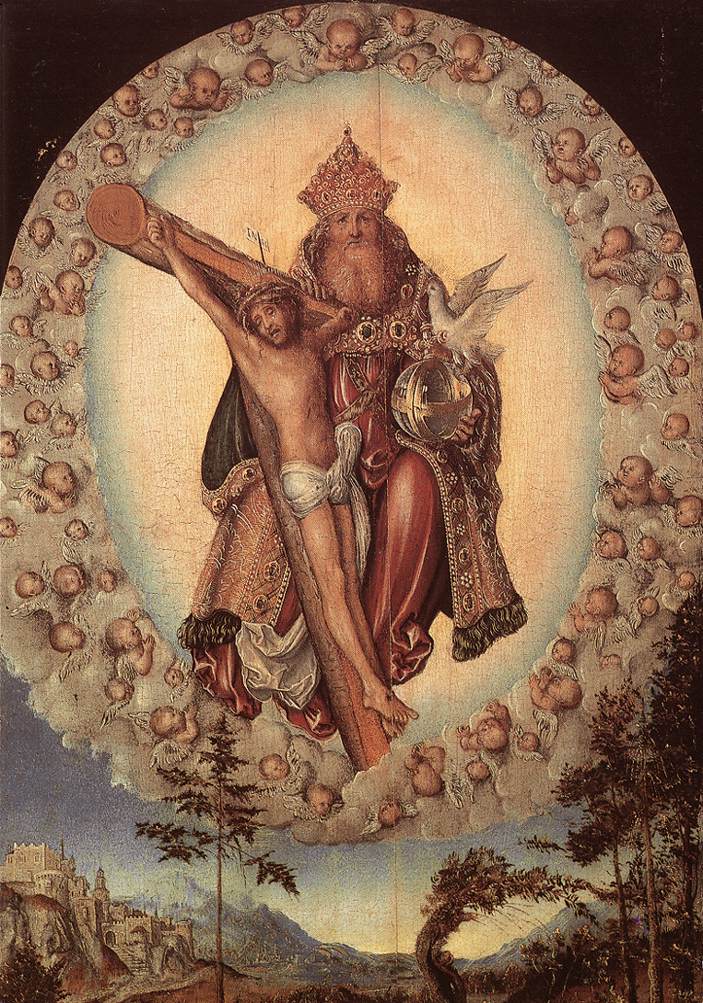
Image Source: AB/Wikipedia. The Holy Trinity in an angelic glory over a landscape, by Lucas Cranach the Elder (d. 1553)
As a primary means of salvation, sacraments strengthen the Christian’s union with Christ. In doing this, they draw the Christian more deeply into union with the Church, who is Christ’s body. In fact, the social-ecclesial effect of the sacraments is so foundational for de Lubac that one cannot be united to Christ except through the Church. All sacraments are sacraments of the Church, and in the Church alone do they produce their full effect. Chief among these means of grace, the Eucharist is the sacrament of unity par excellence. Through participation in the one bread, those who are many are brought into unity (c.f. 1 Corinthians 10:17). De Lubac examines various texts from the Patristic period that refer to unity of the Church being effected by the Eucharist. One Church Father whom he cites is St. Cyril of Alexandria, who writes, “We are all of us, by nature, separately confined in our own individualities, but in another way, all of us are united together. Divided as it were into distinct personalities…we are, so to say, molded into one sole body in Christ, feeding on one flesh alone. One Spirit singles us out for unity, and as Christ is one and indivisible we are all no more but one in him. So did he say to his heavenly Father, ‘That they may be one, as we are one.’”4
The social-ecclesial effect of the sacraments is so foundational for de Lubac that one cannot be united to Christ except through the Church.
De Lubac notes however that in the history of the Church a slow inversion took place between the meanings of the expressions the “mystical body” and “the true body.” In the early Church, the mystical body (corpus mysticum) referred to the Eucharistic body, whereas the true body (corpus verum) was understood as the ecclesial body. Nevertheless, in the 11th and 12th centuries the referents of these terms switched. In order to defend the real presence against views that denied Christ’s substantial presence in the Eucharist, theologians began to speak of the true body as the Eucharist. The shift in meaning of mystical and true, coupled with a new style of reasoning that emerged in the Middle Ages, would result in a weakening of the link between the Church and the Eucharist. Whereas previously, “mystical” had referred to the sacrament or mystery, now it becomes opposed to the visible or true.5
At the heart of this change, or “sacramental forgetfulness,” as de Lubac diagnosed it, was a change in the manner of reasoning. The patristic cosmology was profoundly anagogical. “Anagogy” derives from the Greek word for “ascent” or climb” and, as such, in an anagogical world-view, every sensible thing is a “sacrament” that ascends to Christ and through him to the invisible God. For the early Church, rationality and contemplation therefore went hand in hand. However, beginning with Berengar of Tours (999-1088) and then developing in the 12th century, contemplation was separated from rationality and replaced by demonstration.6 Berengar himself achieved notoriety in his favoring of a “spiritual” or figural consuming of Christ’s body and blood and, in effect, denying that we receive the reality of Christ’s body and blood in the Eucharist. Berengar’s views were condemned by Popes Nicholas II and Gregory VII. Happily, at the end of his life Berengar wrote his Memoir apologizing for his errors.7
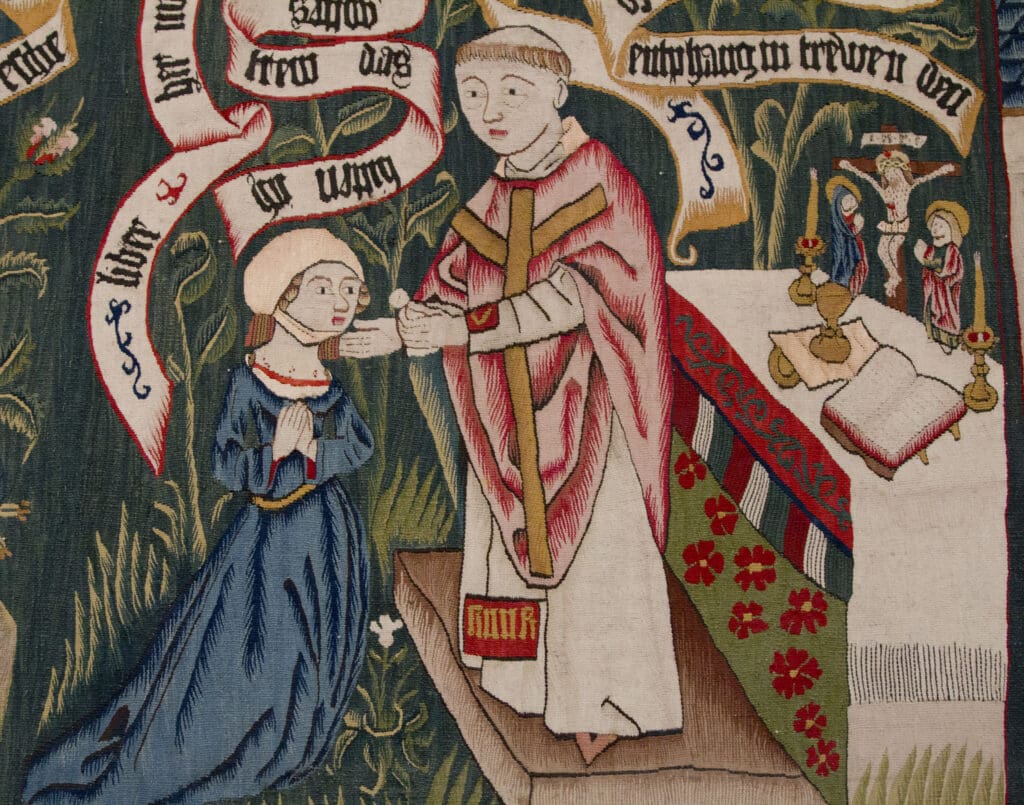
Image Source: AB/Lawrence OP on Flickr.
Resurrecting Symbol
It is the contention of de Lubac that the rationalism and dialectic which Berengar introduced led to the death of a truly symbolic and sacramental understanding of the Eucharist.8 To oppose mystical and true, or symbolic and real, would have been utterly foreign to the patristic mind. The dialectical method therefore separated what tradition had always unified: true and mystical became true or mystical; symbolic and real became symbolic or real. For de Lubac, a new era in human thought that had given reason an eminent role had emerged: “Understanding was entering into a new era, and Berengar of Tours, however mediocre his genius might have been, was nevertheless one of its first examples and most vigorous architects.”9
The loss of the anagogical and its replacement with the dialectical is no less serious a danger for the Church today, despite the prescient warnings of de Lubac. In his introduction to de Lubac’s Catholicism, then-Cardinal Joseph Ratzinger wrote: “If previously there was a narrowing of the Christian vision to an individualism, we are now in danger of a sociological leveling down. Sacraments are often seen merely as celebrations of the community.”10 This is because in an anagogical understanding of the Eucharist, communion with Christ’s Eucharistic body efficaciously signifies our communion in his ecclesial body, certainly with the local parish, and also the universal Church, and ultimately the Church purified and glorified. In essence, with the anagogical we can attest to both the real presence and Christ’s presence in the local Church community. However, with a dialectical approach, the temptation is to emphasize Christ’s presence in the local Church and instrumentalize his substantial presence in the Eucharist.
To oppose mystical and true, or symbolic and real, would have been utterly foreign to the patristic mind.
It is precisely this “sociological order” or, to use Ratzinger’s phrase, “leveling down,” that de Lubac is trying to avoid. It is not the community that assembles to make the Church; it is the Eucharist that makes the ecclesial community. A community-centered model of the Eucharist was exactly what de Lubac was negating when he coined his famous saying: “Now, the Eucharist is the mystical principle, permanently at work at the heart of Christian society, which gives concrete form to this miracle [i.e., the Church]. It is the universal bond, it is the ever-springing source of life. Nourished by the body and blood of the Savior, his faithful people thus all ‘drink of the one Spirit,’ who truly makes them into one single body. Literally speaking, therefore, the Eucharist makes the Church.”11
The reduction of the Church to a specific community realized by the Eucharist was not what de Lubac intended—nor, more importantly, was it ever intended by the Magisterium. The Eucharist, according to de Lubac, is the effective sign of both Christ and his union with his members in the Church and therefore refers to the whole Christ or the totus Christus. The totus Christus is the fullness of Christ as head and bridegroom united to his body and spouse, the Church. It therefore also refers to the heavenly Church. This anagogical or sacramental understanding could not be further from the theology contained in many post-conciliar hymns that focus exclusively on the local parish.
We can summarize this first section by stating that in de Lubac’s Eucharistic ecclesiology, there is a causal link between the Eucharist and the Church. The Eucharist makes the Church. This means that the definitive reality brought about by the Eucharist is the unity of the Church—the Eucharistic body is the source of the ecclesial body. Furthermore, through the Church’s union with Christ, which is signified in the celebration of the Eucharist, we have a foretaste of that union eschatologically fulfilled in the wedding feast of the Lamb.
The Holy Spirit and Sacrifice
There are two interrelated sources of this unity between Christ and his Church, according to de Lubac, that deserve special focus. The first is the role of the Holy Spirit in effecting the communion of the Church. The second is the part that sacrifice plays in bringing about union. For de Lubac, the Spirit’s role in the effecting of unity in the Eucharist is fundamental. The Holy Spirit is the bond of love between the Father and the Son. It is the Holy Spirit who is the fulfillment of the Son’s prayer that the Church may be one as he and the Father are one, in the communion of the Holy Spirit (c.f. John 17:21).
De Lubac turned to the anaphoras, or Eucharistic prayers, of the Eastern rites for the earliest witness to the role of the Holy Spirit in gathering the Church into unity. In examining the Eastern anaphoras, de Lubac noted that the epiclesis, the petitioning of the Father to send the Spirit, was a prayer for union. He quotes the liturgy of St. Basil in this regard: “May all of us who partake of this one bread and chalice be united to one another in the communion of the same Holy Spirit.”12
The Holy Spirit, who was at work in the Incarnation (c.f. Luke 1:35), is also at work in the Eucharist and in effecting the unity of the Church. De Lubac states: “This Holy Spirit…intervenes too in the confection of the Eucharist for the making of his Mystical Body.”13 As such, when he says that the Eucharist makes the Church, it is done so by Christ through the power of the Holy Spirit. For the Christian, the Eucharist completes what has begun in baptism. Through the one Spirit, he has been baptized into one body, the Church. In partaking of the one bread and chalice, and by the action of the Holy Spirit, there is a perfecting of this unity.
Finally, in considering the role of the Holy Spirit in the making of the Church, we see that it is the Spirit who transforms the sacrifice of the community so that it may be “acceptable” to the Father. This too is a central theme that is taken up by de Lubac14 and will be developed further in our discussion below on the importance of sacrifice in understanding the Eucharist’s relation to the Church. John Paul II, who collaborated with de Lubac during the Second Vatican Council, was able to distil in a typical de Lubacian manner the mission of the Holy Spirit in the acceptance of the sacrifice of the faithful in his 1986 encyclical letter, Dominum et vivificantem (“On the Holy Spirit in the Life of the Church”): “The Holy Spirit as Love and Gift comes down, in a certain sense, into the very heart of the sacrifice which is offered on the Cross…. He consumes this sacrifice with the fire of the love which unites the Son with the Father in the Trinitarian communion.”15
While de Lubac would certainly agree that there has been within Christianity the danger of individualism, he would be surprised that the mention of sacrifice has almost been eradicated from the language of contemporary Eucharistic theology. There are theologians today who, while aiming to emphasize the unity of the Church realized by the Eucharist, tend to focus on the meal aspect of the Eucharist and downplay the sacrificial nature of the Mass. And yet, as de Lubac makes clear in Catholicism, sacrifice is central to unity, referring to suffering as the “very crucible wherein unity is forged.”16 It is this latter dimension which has been ignored in much post-conciliar Eucharistic theology.
In the Teeth of Sacrifice
For de Lubac, the outward sign of bread in the Eucharist signifies more than a simple meal shared by the community. Quoting the mid-12th-century de Sacramentis of Master Simon, de Lubac notes the sacrificial imagery employed. In the making of bread, grain is wetted, milled, and baked in fire. Master Simon sees this process as symbolically representing the life of the Christian. The Christian is wetted in baptism, crushed between millstones of hope and fear, and baked in the fire of passion and sorrow. So too are the grapes crushed in the production of wine.17
St. Ignatius of Antioch was another witness to the link between the Eucharist and the suffering of the Christian. Ignatius wrote: “I am the wheat of Christ; let me be crushed by the teeth of the beasts to become the bread of Christ.”18 This is far from an over-active allegorizing; rather, it is the unity that the early Church saw between the Eucharist and the life of the Christian in the Church. The Eucharist is the memorial of the Lord’s death on the Cross and, through partaking in the Eucharist, Christians truly become “branches of the Cross.”19
In Splendour of the Church, which represents de Lubac’s theological application of the historical study of Corpus Mysticum, de Lubac highlights the role of sacrifice in the making of the Church. As a sign, the Eucharist effects the spiritual sacrifice that the totus Christus offers to the Father in the Holy Spirit. This sacrifice is the sacrament of Christ’s passion and a memorial of his death. For de Lubac, the entire Eucharistic reality is linked to Calvary.
The Christian is wetted in baptism, crushed between millstones of hope and fear, and baked in the fire of passion and sorrow. So too are the grapes crushed in the production of wine.
There is a twofold dynamism in the celebration of the Eucharist and therefore the making of the Church. De Lubac expresses this dynamism thus: “the mystery of communication is rounded out in a mystery of communion.”20 Therefore, the faithful are called to participate in and to enter into communion with this sacrifice. De Lubac clearly understands the priesthood of the baptized although he correctly distinguishes between the priesthood of the faithful who offer spiritual sacrifice and that of the clergy who offer the sacrifice of the Eucharist. These two participations in the one priesthood of Christ—that by the clergy and by the laity—truly constitute a priestly community, especially in relation to the world.
The role of the faithful is to receive the fruit of the sacrifice through the reception of communion and, through this communion, bring about their interior sacrifice. In scholastic terms we would describe this as the disposition necessary for the effects of the Eucharist to bear fruit (ex opere operantis). The term de Lubac uses is “assimilation.” The Christian is assimilated into Christ and in so doing becomes the body of Christ. Through sharing in Christ’s death on Calvary in the sacrifice of the Mass, the Christian is thus assimilated by the Holy Spirit through Eucharistic communion into communion with the Church and the Trinity.
The path to communion is therefore self-sacrifice in union with Christ. It is, in effect, the path of love and self-renunciation. The Holy Spirit, the “fire of love,” purifies our self-gift so that it might become an oblation acceptable to the Father. This transforming love both kills and vivifies, which is why Henri de Lubac, quoting St. Augustine, states: “The fortitude of charity could not have been expressed more wondrously than when it was said: mighty love is like death…. And since charity itself kills what we were, so that we be what we were not, love has made in us a sort of death.”21
Conclusion
It is thus sacrifice that leads to love and communion. As such, it is Calvary more than the table that brings about unity. As we have presented above, this is because, in the first place, the community—through the sacramental body—participates in the life of the heavenly Church and therefore the nuptial union with the Lamb. Secondly, the faithful are called to recognize the Lamb’s presence in the Eucharist and to be assimilated into his “Yes” of sacrifice on Calvary. It is still Christ, through his Holy Spirit, who gathers the Church. Thirdly, this union is not so much the fellowship of a simple meal shared with friends: it is the higher union involved in conversion and purification and as such takes the shape of the Cross. It is our participation in the Cross—the sign of the Son’s communion with his Father in the Holy Spirit—that becomes the source of our communion with Christ and with our fellow Christians in the ecclesial body.
Owen Vyner, Ph.D., is Associate Professor of Theology and Chair of the Theology Department at Christendom College, Front Royal, VA.
Footnotes
- For the fragmenting or pluralizing effects of modernity see Peter L. Berger, The Heretical Imperative: Contemporary Possibilities of Religion and Affirmation (London: Collins, 1980).
- Paul McPartlan, Sacrament of Salvation: an Introduction to Eucharistic Ecclesiology (Edinburgh: T & T Clark, 1995), 45.
- For de Lubac’s thought on the Eucharist see the aforementioned Corpus Mysticum: The Eucharist and the Church in the Middle Ages (Notre Dame: University of Notre Dame Press, 2006). His two principle treatments of ecclesiology can be found in Splendour of the Church (New York: Sheed and Ward, 1956) and Catholicism: Christ and the Common Destiny of Man (San Francisco: Ignatius Press, 1988). De Lubac’s writings on anthropology and the nature-grace debate are treated in The Mystery of the Supernatural (New York: Herder and Herder, 1998).
- De Lubac, Catholicism, 91.
- De Lubac, Corpus Mysticum, 223.
- De Lubac, Corpus Mysticum, 235.
- James T. O’Connor, The Hidden Manna: A Theology of the Eucharist (San Francisco: Ignatius Press, 2005), 97-111.
- O’Connor, The Hidden Manna, 225.
- O’Connor, The Hidden Manna, 228.
- De Lubac, Catholicism, 12.
- De Lubac, Corpus, 88.
- De Lubac, Catholicism, 106.
- De Lubac, Catholicism, 110.
- C.f. De Lubac, Splendour, 106-107.
- John Paul II, Dominum et Vivificantem: On the Holy Spirit in the Life of the Church and the World (Boston: St. Paul Editions, 1986), no. 41. “The Old Testament on several occasions speaks of ‘fire from heaven’ which burnt the oblations presented by men. By analogy one can say that the Holy Spirit is the ‘fire from heaven’ which works in the depth of the mystery of the Cross.” De Lubac, Catholicism, 110: “[The Holy Spirit] fell upon the sacrifice of Elias as a devouring fire burns up the dross in humankind, the obstacle to the unifying power of the sacrament.”
- De Lubac, Catholicism, 95.
- De Lubac, Catholicism, 95.
- De Lubac, Catholicism, 95.
- St. Ignatius of Antioch, Letter to the Trallians, in Schoedel, 152.
- De Lubac, Splendour, 108.
- De Lubac, Mystery of the Supernatural, 29, footnote 55, Quoting St. Augustine’s commentary on Psalm 122.
